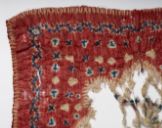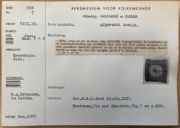A Grand Reveal
Step number seven. This figure shows a sample of the fabric as it is gradually unfolded and dried.
“The dyeing operations are now finished, all the knots and ties are undone, and after opening out, the result is a green centre with a red border, both containing white spots…” There is a sense of wonder in opening up the cloth to reveal the pattern that has been created, as if by magic, by the dyes and hands of the maker.
“It’s crumpled, uneven aspect seems to heighten the beautiful effect of the combined colours and figures”
Driessen’s appreciation of the handicraft seems to rival the industrialisation that he was a part of back home in Leiden. These parallels have continued throughout history. Tie dye rose in popularity again in the 1960’s as a symbol for protest, where the psychedelic swirls of colour represented freedom and peace during the Vietnam War. More recently during the pandemic, people were searching for creative freedom from lockdown. Tie dye provided a solution to this as it is easy to do yourself from home with few materials, making it an unofficial craft of quarantine.
Today, high fashion brands have monetised this aspect of the craft into trends seen on the runway. How does this change its social significance? Long before it was a festival favourite or pandemic pastime, Felix Driessen was interested in tie-dye. When he replicated the craft that he had experienced in Indonesia back in the Netherlands, some of its symbolism was lost. Although each tie-dye reveal is different, its links to social upheaval and community seem to unite people throughout history.


